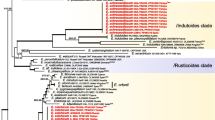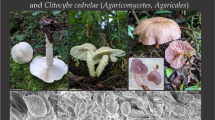Abstract
Genetic differences between 36 Pholiota aurivella wild isolates collected from 13 decayed logs of Salicaceae trees distributed along about 1200 m of a streambed in a forest were characterized by somatic incompatibility and mating tests, and by restriction fragment length polymorphism (RFLP) analysis of mitochondrial DNA (mtDNA). There was a perfect correlation between somatic incompatibility and mating type groups, and isolates could be divided into 15 genets (genetically identical clones). Because the mtDNAs of the 36 wild isolates have 14 different EcoRI RFLP patterns, they likely originated from at least 14 distinct wild strains, indicating that multiple wild strains with distinct genetic compositions coexist in the forest investigated in this study. mtDNA variation of P. aurivella is apparently very high despite the close proximity of sample collection sites within the forest. The territories of single P. aurivella genets within a host log are apparently larger than other nonpathogenic wood-decaying basidiomycetes reported previously, such as Flammulina velutipes and Lentinula edodes.
Similar content being viewed by others
References
I Arita K Mimura (1969) ArticleTitleThe mating system in some Hymenomycetes II. The mating system in Favolus arcularius (Batsch. ex Fr.) Ames, F. mikawai (Lloyd) Imaz., Pholiota adiposa (Fr.) Quél. and Pleurotus cornucopiae (Paul. ex Pers.) Roll. (in Japanese with English abstract) Rep Tottori Mycol Inst 7 51–58
H Bae EM Hansen SH Strauss (1994) ArticleTitleRestriction fragment length polymorphisms demonstrate single origin of infection centers in Phellinus weirii Can J Bot 72 440–447 Occurrence Handle1:CAS:528:DyaK2cXmt1KitLc%3D
SW Chiu ZM Wang WT Chiu FC Lin D Moore (1999) ArticleTitleAn integrated study of individualism in Lentinula edodes in nature and its implication for cultivation strategy Mycol Res 103 651–660 Occurrence Handle10.1017/S095375629900859X
A Economou V Lees PJ Pukkila ME Zolan LA Casselton (1987) ArticleTitleBiased inheritance of optional insertions following mitochondrial genome recombination in the basidiomycete fungus Coprinus cinereus Curr Genet 11 513–519 Occurrence Handle10.1007/BF00384614 Occurrence Handle1:CAS:528:DyaL2sXhvFShs7o%3D
M Fukuda Y Fukumasa-Nakai (1996) ArticleTitleGenetic evidence supporting the multicellular origin of fruiting body formation in the basidiomycete, Lentinula edodes Mokuzai Gakkaishi 42 1025–1028 Occurrence Handle1:CAS:528:DyaK28XntVOgtbc%3D
M Fukuda Y Mori (2003) ArticleTitleGenetic differences in wild strains of Lentinula edodes collected from a single fallen tree Mycoscience 44 365–368 Occurrence Handle10.1007/s10267-003-0127-y Occurrence Handle1:CAS:528:DC%2BD2cXltVamuw%3D%3D
M Fukuda K Tokimoto (1991) ArticleTitleVariation of isozyme patterns in the natural population of Lentinus edodes Proc Jpn Acad 67 IssueIDB 43–47 Occurrence Handle10.2183/pjab.67.43
M Fukuda YF Nakai DS Hibbett T Matsumoto Y Hayashi (1994) ArticleTitleMitochondrial DNA restriction fragment length polymorphisms in natural population of Lentinula edodes Mycol Res 98 169–175 Occurrence Handle1:CAS:528:DyaK2cXksFWjtbk%3D
M Fukuda Y Harada S Imahori Y Fukumasa-Nakai Y Hayashi (1995) ArticleTitleInheritance of mitochondrial DNA in sexual crosses and protoplast cell fusions in Lentinula edodes Curr Genet 27 550–554 Occurrence Handle7553940 Occurrence Handle10.1007/BF00314446 Occurrence Handle1:CAS:528:DyaK2MXmslegt7k%3D
M Fukuda M Fujishima K Nakamura (2000) ArticleTitleGenetic differences among the wild isolates of Flammulina velutipes collected from a fallen tree of Broussonetia papyrifera Rep Tottori Mycol Inst 38 23–31
Y Fukumasa-Nakai T Matsumoto M Fukuda (1992) ArticleTitleEfficient isolation of mitochondrial DNA from higher basidiomycetes for restriction endonuclease analysis Rep Tottori Mycol Inst 30 60–68
DS Hibbett Y Fukumasa-Nakai A Tsuneda MJ Donoghue (1995) ArticleTitlePhylogenetic diversity in shiitake inferred from nuclear ribosomal DNA sequences Mycologia 87 173–182 Occurrence Handle10.2307/3760806
WE Hintz JB Anderson PA Horgen (1988) ArticleTitleNuclear migration and mitochondrial inheritance in the mushroom Agaricus bitorquis Genetics 119 35–41 Occurrence Handle17246425
R Imazeki T Hongo (1987) Colored illustrations of mushrooms of Japan, vol I (in Japanese) Hoikusha Osaka 207
H Kawagishi (Eds) (2005) Biological activities and functions of mushrooms (in Japanese) CMC Publishing Tokyo
E Kay R Vilgalys (1992) ArticleTitleSpatial distribution and genetic relationships among individuals in a natural population of oyster mushroom Pleurotus ostreatus Mycologia 84 173–182 Occurrence Handle10.2307/3760248
GA Kile (1993) ArticleTitleIdentification of genotypes and clonal development of Armillaria luteobubalina Walting & Kile in Eucalypt forest Aust J Bot 31 657–671 Occurrence Handle10.1071/BT9830657
T Matsumoto Y Fukumasa-Nakai (1995) ArticleTitleMitochondrial DNA restriction fragment length polymorphisms and phonetic relationship in natural populations of the oyster mushroom Pleurotus ostreatus Mycol Res 99 562–566 Occurrence Handle1:CAS:528:DyaK2MXms1SqsLg%3D
T Matsumoto Y Fukumasa-Nakai (1996) ArticleTitleMitochondrial DNA inheritance in sexual crosses of Pleurotus ostreatus Curr Genet 30 549–552 Occurrence Handle8939817 Occurrence Handle10.1007/s002940050168 Occurrence Handle1:CAS:528:DyaK2sXnvVGntA%3D%3D
T Matsumoto K Mimura Y Fukumasa-Nakai (1995) ArticleTitleIsozyme variation and genetic relatedness among natural populations of Pleurotus ostreatus J Gen Appl Microbiol 41 487–497 Occurrence Handle1:CAS:528:DyaK28XhtlSis7k%3D
K Nishizawa Y Amano K Nozaki N Hosokawa M Shiroishi T Kanda (2003) ArticleTitleSome characteristics of three groups in Flammulina velutipes classified by analysis of esterase isozymes Mycoscience 44 19–23 Occurrence Handle10.1007/s10267-002-0076-x Occurrence Handle1:CAS:528:DC%2BD3sXjsFWjurc%3D
Y Obatake T Matsumoto K Mimura Y Fukumasa-Nakai (2002) ArticleTitleGenetic relationships in natural population of Pholiota nameko from Japan based on DNA polymorphisms Mycoscience 43 463–469 Occurrence Handle10.1007/s102670200067 Occurrence Handle1:CAS:528:DC%2BD3sXhvVyrsrc%3D
ML Smith JN Bruhn JB Anderson (1992) ArticleTitleThe fungus Armillaria bulbosa is among the largest and oldest living organisms Nature (Lond) 356 428–431 Occurrence Handle10.1038/356428a0
K Tokimoto M Komatsu T Takemaru (1973) ArticleTitleIncompatibility factors in the natural population of Lentinus edodes in Japan (in Japanese with English abstract) Rep Tottori Mycol Inst 10 371–376
JJ Worrall (1994) ArticleTitlePopulation structure of Armillaria species in several forest types Mycologia 86 401–407 Occurrence Handle10.2307/3760572
Author information
Authors and Affiliations
Corresponding author
About this article
Cite this article
Fukuda, M., Mori, Y. & Yamada, A. Genetic variability among Pholiota aurivella isolates from a small natural population. Mycoscience 48, 381–387 (2007). https://doi.org/10.1007/s10267-007-0381-5
Received:
Accepted:
Published:
Issue Date:
DOI: https://doi.org/10.1007/s10267-007-0381-5




